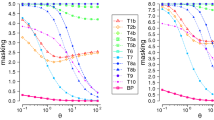Abstract
Outlier detection is an important task for fitting a model to a set of data. Two different outlier detection approaches are given as tests for outliers and robust methods. For these approaches, usually outliers are considered as additive bias terms neglected in the original adjustment model. However, there is another approach that outlier is considered as a model error in the Gauss–Markov model. This model error is represented as an unknown parameter. As it cannot be known before which observation includes outlier; this method is applied on the data for each observation separately and tested with t-test or F-test. It is successful if the sample includes only one outlier. To detect multiple outliers more successfully, in this article, a new outlier detection method is introduced. In this method, all the possible combinations of multiple outliers are considered as model errors and it is accepted that the smallest variance of them gives the solution for a certain number of outliers, then the estimated model errors are detected by comparing with a critical value. The critical value is chosen as 3σo. To compare the results of the new method, with those of the Least Median of Squares (LMS) and Huber M-estimators, Monte Carlo simulation technique is used for linear regression. The Mean Success Rate is proposed to measure the reliabilities of the methods. We showed that the new method is robust and includes the property of high breakdown point as LMS; and more efficient than LMS.
Similar content being viewed by others
References
Baarda, W., A Testing Procedure for Use in Geodetic Networks, Publication on Geodesy, New series 2, no. 5., Netherlands Geodetic Commission, Delft, (1968).
Pope, A.J., The Statistics of Residuals and the Outlier Detection of Outliers, NOAA Technical Report, NOS 65, NGS 1, Rockville, MD (1976).
Heck, B., “Der Einfluss einzelner Beobachtungen auf das Ergebnis einer und die Suche nach Ausreissern in den Beobachtungen,” AVN 88: 17–34 (1981).
Pelzer, H., Geodatische Netze in Landes–und İngenieurvermessung II- Oberprüfung von Ausgleichungsmodellen Konrad Wittwer Verlag-Stuttgart (1985).
Koch, K.R., Parameter Estimation and Hypothesis Testing in Linear Models, 2nd Edition, Springer-Verlag, Berlin (1999).
Baselga, S., “Critical Limitation in Use of τ Test for Gross Error Detection,” Journal of Surveying Engineering 133(2): 52–55 (2007).
Huber, P.J., “Robust Estimation of a Location Parameter,” The Annals of Mathematical Statistics 35: 73–101 (1964).
Huber, P.J., Robust Statistics, John Wiley and Sons, New York (1981).
Hampel, F.R., Ronchetti, E.M., Rousseeuw, P.J., and Stahel, W.A., Robust Statistics: The Approach Based on Influence Functions, John Wiley and Sons, New York (1986).
Rousseeuw, P.J., and Leroy, A.M., Robust Regression and Outlier Detection, John Wiley and Sons, New York (1987).
Koch, K.R., “Robuste Parameterschaetzung,” AVN 103: 1–18 (1996).
Yang, Y., He, H., and Xu, G., “Adaptively Robust Filtering for Kinematic Geodetic Positioning,” Journal of Geodesy 75(2/3): 109–116 (2001).
Yang, Y., Song, L., and Xu, T., “Robust Estimator for Correlated Observations Based on Bifactor Equivalent Weights,” Journal of Geodesy 76(6–7): 353–358 (2002).
Hekimoglu, S., “Do Robust Methods Identify Outliers More Reliably than Conventional Tests for Outliers?” ZFV 5(3): 174–180 (2005).
Xu, P.L., “Sign-constrained Robust Least Squares, Subjective Breakdown Point and the Effect of Weights of Observations on Robustness,” Journal of Geodesy 79: 146–159 (2005).
Koch, K.R., “Outlier Detection in Observations Including Leverage Points by Monte Carlo Simulations,” AVN 114(10): 330–336 (2007).
Erenoglu, R.C., and Hekimoglu, S., “Efficiency of robust methods and tests for outliers for geodetic adjustment models,” Acta. Geodaetica et Geophysica Hungarica 45(4): 426–439 (2010).
Gui, Q., Gong, Y., Li, G., and Li, B. “A Bayesian Approach to the Detection of Gross Errors Based on Posterior Probability,” Journal of Geodesy 81(10): 651–659 (2007).
Gui, Q., Li, X., Gong, Y., Li, B., and Li, G., “A Bayesian Unmasking Method for Locating Multiple Gross Errors Based on Posterior Probabilities of Classification Variables,” Journal of Geodesy 85(4): 191–203 (2011).
Sun, W., “A New Method for Localization of Gross Errors,” Survey Review 32: 344–358 (1994).
Cen, M., Li, Z., Ding, X., and Zhuo, J., “Gross Error Diagnostics Before Least Squares Adjustment of Observations,” Journal of Geodesy 77(1): 503–513 (2003).
Xia, X.T.,Wang, Z.Y., and Gao, Y.S., “Gross Error Detection Using Fuzzy-Set Theory,” Proceedings of the 3rd International Symposium Instrumentation Science and Technology, Vol. 1, Xian, China, 120–127, 2004.
Schaffrin, B, and Zewen, W., “Multiplicative Outlier Search Using HomBLUP and An Equivalence Theorem,” Manuscripta Geodaetica 20(1): 21–26 (1994).
Cook, R.D., and Weisberg, S., Residuals and Influence in Regression, Chapman and Hall, New York (1982).
Schall, R., and Dunne, T.T., “A Unified Approach to Outliers in the General Linear Model,” Sankhya, The Indian Journal of Statistics B15: 157–167 (1988).
Hekimoglu, S., and Koch, K.R., “How Can Reliability of the Robust Methods be Measured?”, Proc., Altan, M.O., and Gründig, L. (eds), Third Turkish-German Joint Geodetic Days, Istanbul, 1, 179–196 (1999).
Chatterjee, S., and Hadi, A.S., Sensitivity Analysis in Linear Regression, John Wiley and Sons, New York (1988).
Hadi, A.S., and Simonoff, J.S., “Procedures for the Identification of Multiple Outliers in Linear Models,” Journal of the American Statistical Association 88: 1264–1272 (1993).
Rousseeuw, P.J., “Least Median of Squares Regression,” Journal of the American Statistical Association 79: 871–880 (1984).
Hampel, F.R., “Beyond Location Parameters: Robust Concepts and Methods,” Bulletin of the International Statistical Institute 46(1): 375–382 (1975).
Hekimoglu, S., and Erenoglu, R.C., “A New Robust Method in Linear Regression,” Journal of Surveying Engineering 135(3): 1–5 (2009).
Hekimoglu, S., and Koch, K.R., “How Can Reliability of Tests for Outliers be Measured?” AVN 107(2): 247–254 (2000).
Author information
Authors and Affiliations
Corresponding author
Rights and permissions
About this article
Cite this article
Hekimoglu, S., Erdogan, B. & Erenoglu, R.C. A new outlier detection method considering outliers as model errors. Exp Tech 39, 57–68 (2015). https://doi.org/10.1111/j.1747-1567.2012.00876.x
Received:
Accepted:
Published:
Issue Date:
DOI: https://doi.org/10.1111/j.1747-1567.2012.00876.x




